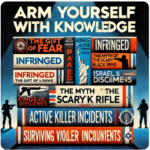Posted on March 26, 2025 by Doris Wise, Jews Can Shoot
Today, the Supreme Court’s 7-2 ruling in Bondi v. VanDerStok upheld the ATF’s 2022 regulation classifying ghost gun kits as “firearms” under the Gun Control Act of 1968. For those of us at Jews Can Shoot, this isn’t just a legal setback—it’s a slap in the face to the Second Amendment and a chilling echo of why we fight for our rights. Jewish history, especially during the Holocaust, proves what’s at stake when the government controls who can arm themselves.
The ATF’s rule targets unassembled kits—80% lowers, parts you can finish at home with skill and tools. These “ghost guns” don’t have serial numbers, and that’s no accident. They’re the modern version of a tradition as old as America: crafting your own arms. Go back to the Holocaust—Jewish partisans in the forests of Eastern Europe didn’t stroll into a gun shop. Facing the Nazi war machine, they scavenged parts, improvised weapons, and built what they needed to fight back. From scraps of metal and smuggled components, they made guns to defend their lives and strike at tyranny. That ingenuity kept them alive. Today’s ghost guns are their spiritual descendants, and the ATF just put a chokehold on that legacy.
The Court’s majority—Gorsuch, Roberts, Kavanaugh, Barrett, Sotomayor, Kagan, and Jackson—said these kits are “readily convertible” into firearms, so the feds can slap on serialization, background checks, and licenses. Seven justices, including some we’d counted on for originalism, handed the government a blank check to regulate anything that might become a gun. For a people who’ve seen what happens when the state disarms you—think Warsaw Ghetto, 1943—this is a dangerous precedent.
Justice Clarence Thomas, again, stood tall in dissent, joined by Samuel Alito. Thomas argued the Gun Control Act’s definition of a “firearm”—something that “will or is designed to or may readily be converted to expel a projectile”—covers finished weapons or frames, not a pile of parts. He even included a visual (a rare Supreme Court flex) to show what’s obvious: an unfinished receiver isn’t a gun, just like a partisan’s scavenged barrel wasn’t a rifle until he made it one. Thomas knows the ATF overstepped—Congress didn’t write a law to micromanage every potential piece of a firearm. That’s our right, not their playground. Justice Thomas’s dissent called it out: the ATF shouldn’t get to stretch a 1968 law to cover ghost guns without Congress saying so. The system lets agencies act first and forces citizens to claw back their rights through years of litigation. That’s how a non-judicial body’s decision ends up at SCOTUS—it’s not the ATF ruling, it’s the courts wrestling with the ATF’s overreach.
Pam Bondi, stepping in as AG after Garland, could’ve yanked this case and honored 2A freedom. She didn’t. Her DOJ, via Solicitor General Elizabeth Prelogar, clung to the Biden-era claim that the ATF’s rule fits the statute. They cited crime stats—19,000 ghost guns recovered in 2021, up from 1,600 in 2017—but those numbers don’t justify stripping millions of us of our constitutional birthright. Bondi missed a chance to echo the defiance of those partisans who built their own salvation.
The real heroes here are Jennifer VanDerStok, the Firearms Policy Coalition, and their co-plaintiffs. They fought for the principle that the Second Amendment shields our ability to make arms, not just buy them. For Jews, this isn’t theoretical. When the Nazis rounded us up, the partisans who resisted—armed with whatever they could cobble together—showed why we can’t let that right slip. The majority’s ruling opens a door to more control: if parts are fair game, what’s next—ammo? Tools? The Holocaust taught us: when the government decides who’s armed, the vulnerable pay the price.
Thomas and Alito held the line, but 7-2 means we’re on our own. At Jews Can Shoot, we take that lesson to heart. Build your guns, train your hands, and guard your freedom—because history doesn’t wait for permission.
Stay armed, stay free.



